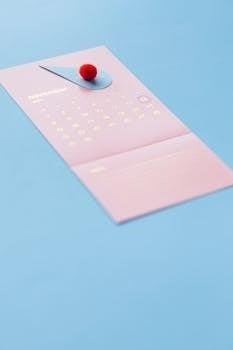Overview of the 2023 NRP Algorithm Update
The 2023 update to the Neonatal Resuscitation Program (NRP) guidelines is a focused revision based on four systematic reviews by the ILCOR Neonatal Life Support Task Force. This update includes key changes in practice.
Key Changes in the 2023 Neonatal Resuscitation Guidelines
The 2023 focused update to the NRP guidelines introduces changes based on recent systematic reviews. These revisions address umbilical cord management‚ emphasizing delayed cord clamping‚ especially in preterm infants. Ventilation support is another key area‚ with specific guidance on choosing between face masks and supraglottic airways for positive-pressure ventilation; The update also highlights using T-piece resuscitators and includes modifications to the initial steps of resuscitation‚ incorporating electronic cardiac monitors and specific epinephrine dosing. These changes reflect an evidence-based approach aimed at improving outcomes for newborns.
Focus on Umbilical Cord Management
The 2023 NRP update places significant emphasis on umbilical cord management. It particularly focuses on the practice of delayed cord clamping‚ especially for preterm births.
Delayed Cord Clamping Recommendations
The 2023 NRP guidelines strongly recommend delayed umbilical cord clamping for most newborns‚ particularly preterm infants. This practice allows for continued placental transfusion‚ potentially improving circulatory stability and reducing the risk of intraventricular hemorrhage. The systematic reviews supporting this recommendation highlight the benefits of delayed clamping‚ leading to a shift in standard practice‚ emphasizing that the timing of cord clamping is an important intervention that can influence neonatal outcomes‚ specifically for babies who are born preterm. The updated guidelines offer clear guidance on the implementation of delayed cord clamping in various clinical scenarios.
Ventilation Support in the 2023 Update
The 2023 NRP update emphasizes effective positive-pressure ventilation (PPV) as a priority. The guidelines focus on the choice of interface and the use of a T-piece resuscitator.
Choice between Face Mask and Supraglottic Airway
The 2023 NRP guidelines provide specific guidance on the choice between a face mask and a supraglottic airway for delivering positive-pressure ventilation (PPV) to newborn infants requiring support after birth. The update highlights the importance of effective PPV and offers recommendations for selecting the most appropriate interface based on the infant’s specific needs and the clinical scenario. The focus is on ensuring optimal ventilation is achieved early in the resuscitation process. This choice is crucial for proper oxygenation and overall success of resuscitation efforts.
Use of T-Piece Resuscitator
The 2023 NRP update emphasizes the beneficial use of a T-piece resuscitator for newborn infants requiring ventilation support. This device is recommended with or without positive end-expiratory pressure (PEEP). The guidelines underscore that effective positive-pressure ventilation is a priority‚ and the T-piece resuscitator is considered a valuable tool in achieving this. Its consistent delivery of pressure and the ability to provide PEEP are key advantages‚ supporting improved lung function and better patient outcomes during resuscitation. The update reflects a move towards evidence-based practice in selecting ventilation devices.

The 2023 Update Based on ILCOR Reviews
The 2023 focused update is grounded in four systematic reviews conducted by the ILCOR Neonatal Life Support Task Force. These reviews provide the evidence for the new guidelines.
Systematic Reviews by the ILCOR Neonatal Life Support Task Force
The International Liaison Committee on Resuscitation (ILCOR) Neonatal Life Support Task Force spearheaded comprehensive systematic reviews to underpin the 2023 NRP update. These reviews critically analyzed the scientific literature focusing on areas such as umbilical cord management‚ including delayed cord clamping for preterm and late preterm infants. The team also investigated the most effective ventilation strategies. The task force’s work ensures that the 2023 guidelines are based on the strongest available evidence‚ aiming to improve outcomes for newborns requiring resuscitation. This thorough approach ensures the guidelines are evidence-based and up-to-date.

Deterministic Approach of the NRP Algorithm
The NRP algorithm utilizes a deterministic approach‚ focusing on identifying patterns within data rather than relying on traditional‚ randomized methods. This offers a unique perspective for classification and prediction tasks.
NRP Algorithm as a Novel Pattern Recognition Method
The Neonatal Resuscitation Program (NRP) algorithm presents a novel approach to pattern recognition‚ moving away from conventional randomized methods. Instead‚ it emphasizes the identification of deterministic patterns within data. This methodology provides a distinct perspective on classification and prediction tasks‚ allowing for a more targeted and efficient response during neonatal resuscitation. This approach allows healthcare professionals to quickly assess the situation and implement the necessary interventions based on established patterns of distress‚ enhancing the overall efficacy of the resuscitation process.
Timeline of Resuscitation Events
The 2023 NRP update emphasizes the importance of timing of major interventions in the delivery room. This includes the critical moments for initiating chest compressions and other key steps.
Timing of Major Interventions in Delivery Room
The 2023 NRP guidelines highlight precise timing for key resuscitation events in the delivery room‚ such as initiating positive-pressure ventilation (PPV) and chest compressions. These interventions are crucial for optimal outcomes. The update emphasizes the importance of a systematic approach to promptly assess the infant’s condition and start necessary support‚ especially when heart rate is low or absent. This timeline driven approach aims to streamline delivery room resuscitation‚ ensuring timely and effective care for newborns needing assistance. The protocol ensures that the timing of interventions aligns with the latest evidence based practices.
NRP Advanced Certification Requirements
NRP Advanced certification has specific requirements that became effective March 1‚ 2023‚ for both initial certification and recertification. This ensures a higher level of competency among providers.
Changes in NRP Certification for Healthcare Professionals
The Neonatal Resuscitation Program (NRP) has updated its certification requirements for healthcare professionals‚ emphasizing an evidence-based approach to newborn care. Effective March 1‚ 2023‚ NRP Advanced certification is required for both new certifications and recertifications. These changes aim to ensure that all providers have a strong understanding of the full AAP NRP algorithm and are equipped to provide effective‚ team-based care. The updated requirements reflect the latest scientific evidence and best practices in neonatal resuscitation‚ enhancing the quality of care delivered to newborns at birth.

Integration with Other Resuscitation Guidelines
The 2023 NRP update is aligned with the American Heart Association (AHA) guidelines‚ and the American Academy of Pediatrics (AAP)‚ ensuring a unified approach to resuscitation practices.
Relationship to AHA and AAP Guidelines
The 2023 Neonatal Resuscitation Program (NRP) guidelines represent a focused update to the American Heart Association (AHA) Guidelines for Cardiopulmonary Resuscitation and Emergency Cardiovascular Care‚ as well as the American Academy of Pediatrics (AAP) recommendations. These updates are based on systematic reviews conducted by the International Liaison Committee on Resuscitation (ILCOR). The goal is to ensure that the NRP algorithm is consistent with the latest scientific evidence and integrates seamlessly with broader resuscitation protocols established by the AHA and AAP for improved patient outcomes.

Practical Applications of the 2023 NRP Algorithm
The 2023 NRP algorithm guides healthcare professionals in delivery room resuscitation‚ focusing on evidence-based practices for improved newborn outcomes‚ including effective ventilation and cord management.
Implementation in Clinical Practice
The 2023 NRP algorithm update requires integration into clinical practice through staff training and protocol revisions. Healthcare providers should familiarize themselves with the new guidelines‚ particularly regarding delayed cord clamping and positive pressure ventilation techniques‚ to ensure effective application during neonatal resuscitation. The algorithm’s deterministic approach necessitates a shift in how resuscitation events are approached. This will require consistent application of the algorithm’s steps‚ as well as team-based care. Regular drills and simulations will aid in the proper implementation of these updated protocols.
Resources for NRP Training
NRP training resources include materials and courses from the AHA and AAP. These resources help healthcare professionals gain certification and stay updated on the latest guidelines for neonatal care.
Available Materials and Courses for NRP Certification
The American Academy of Pediatrics (AAP) and the American Heart Association (AHA) provide comprehensive materials for NRP certification. These include textbooks‚ online modules‚ and hands-on training courses. The resources are designed to equip healthcare professionals with the knowledge and skills necessary for effective neonatal resuscitation. These programs convey an evidence-based approach to newborn care. They also facilitate team-based care. Materials include algorithms‚ flowcharts‚ and videos. These materials help in understanding the NRP algorithm and its practical application. Additionally‚ various training centers offer courses for initial certification and recertification.
Additional Considerations
The 2023 NRP guidelines also address specific scenarios and adaptations of the algorithm. These include considerations for preterm infants and unique delivery room challenges‚ ensuring flexibility.
Specific Scenarios and Adaptations of the Algorithm
The 2023 NRP update provides guidance for specific scenarios‚ including preterm births‚ where umbilical cord management and ventilation strategies may differ. Adaptations are also outlined for situations requiring advanced interventions‚ like the use of supraglottic airways or endotracheal intubation. The algorithm emphasizes a flexible‚ team-based approach‚ allowing for adjustments based on the unique needs of each newborn. These guidelines ensure healthcare providers can navigate complex situations effectively‚ promoting the best possible outcomes for all infants‚ including those with special considerations during resuscitation‚ and are based on the latest scientific reviews.